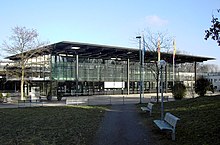Günter Behnisch
Günter Behnisch | |
|---|---|
 | |
| Born | 12 June 1922 |
| Died | 12 July 2010 (aged 88) |
| Nationality | German |
| Alma mater | Technical University in Stuttgart |
| Occupation | Architect |
| Practice | Behnisch & Partner |
Günter Behnisch (12 June 1922 – 12 July 2010) was a German architect, born in Lockwitz, near Dresden. During the Second World War he became one of Germany's youngest submarine commanders. Subsequently, Behnisch became one of the most prominent architects representing deconstructivism. His prominent projects included the Olympic Park in Munich and the new West German parliament in Bonn.
Early life
Behnisch was born the second of three children, in Lockwitz near Dresden.[1] He attended a number of schools, due to the fact his Social Democrat father was arrested, sacked and redeployed to Chemnitz by the new Nazi government.[1]
In 1939, Behnisch volunteered to join the navy (Kriegsmarine), aged 17, which was a less onerous alternative to compulsory labour service, or army conscription.[1] He eventually became a U-boat officer and served aboard U-952. In October 1944, he became one of the youngest U-boat commanders, when he commissioned U-2337.[2] At the end of the Second World War he surrendered his submarine to the British and became a prisoner of war in Featherstone Castle in Northumberland.[1]
Behnisch initially trained as a bricklayer[1] then, in 1947 enrolled to study architecture at the Technical University in Stuttgart.[3] From 1967 to 1987 he was a professor for architectural/building design and industrial building technology at the Technische Hochschule Darmstadt.[4]

Architectural career
He established his own architecture practice in Stuttgart in 1952, [citation needed] which in 1966 became Behnisch & Partner.
In 1967, the architecture firm of Günther Behnisch was selected to developed a comprehensive master plan for the sports and recreation area of the 1972 Summer Olympics in Munich.[5] The area in known as Olympiapark (Olympic Park) and it includes the Olympiastadion (Olympic Stadium).[6] The stadium's tensile structure was developed in cooperation with architect and engineer Frei Otto. One of Behnisch's most notable buildings was the new parliament in the West German capital, Bonn. Although he won the architectural design competition in 1973, the construction only began in 1987, and was completed in 1992.[3]
His son Stefan Behnisch established a separate firm, Behnisch Architekten in 1989.

Main works (selection)
- 1967–72: Olympic Park in Munich, Germany[7]
- 1984–87: Central library of the Catholic University of Eichstätt-Ingolstadt, Eichstätt, Germany
- 1984–90: Museum für Kommunikation Frankfurt, Germany
- 1985–87: HYSOLAR-Building der University of Stuttgart, Germany
- 1987–92: Plenary Complex of the German Parliament (Bundestag) in Bonn, Germany[8]
- 1993–2005: Academy of Arts Building in central Berlin, a six-story glass expansion of the reconstructed Hotel Adlon[9][10]
- 1997: State Clearing Bank – Landesgirokasse in Stuttgart, Germany[11]
- 1998: Control tower at Nuremberg Airport, Germany[12]
- 1998–2002: North German State Clearing Bank in Hanover, Germany[13]
- 1999: Museum der Phantasie, Bernried am Starnberger See, Germany
- 2003: Genzyme Center in Cambridge, Massachusetts, USA[14]
- 2005: Centre for Cellular and Biomolecular Research in Toronto, Canada[15]
References
- ^ a b c d e David Childs, Günter Behnisch: The architect behind Munich's groundbreaking Olympic Stadium, in The Independent (London), 7 August 2010, retrieved 1 March 2012
- ^ Busch & Röll 1999, p. 29.
- ^ a b Thorsten Dörting, Obituary of the Architect Günter Behnisch, in Spiegel online international, 13 July 2010, retrieved 9 August 2010
- ^ Darmstadt, Technische Universität. "Günter Behnisch". Technische Universität Darmstadt. Retrieved 15 September 2019.
- ^ Blundell Jones, Peter (2007). Modern architecture through case studies, 1945–1990. Eamonn Canniffe (1st ed.). Amsterdam. pp. 101–112. ISBN 978-1-135-14409-8. OCLC 810077981.
{{cite book}}: CS1 maint: location missing publisher (link) - ^ Schiller, Kay (2010). The 1972 Munich Olympics and the making of modern Germany. Christopher Young. Berkeley: University of California Press. pp. 104–110. ISBN 978-0-520-94758-0. OCLC 656359238.
- ^ "Sueddeutsche Article on Günther Benisch". Sueddeutsche Newspaper. 13 July 2010. Retrieved 3 June 2014.
- ^ "Plenary Complex of the German Parliament". aedes architecture. Retrieved 3 June 2014.
- ^ "architect Günter Behnisch dies at 88 years". Die Welt. 13 July 2010. Retrieved 3 November 2016.
- ^ "Front history, rear Behnisch The Hotel Adlon in Berlin is extended". BauNetz (German language). 16 September 1999. Retrieved 3 November 2016.
- ^ "State Clearing Bank – Landesgirokasse in Stuttgart". AW Magazine. Archived from the original on 6 June 2014. Retrieved 3 June 2014.
- ^ "Nürnberg International Airport (NUE/EDDN), Nuremberg, Bavaria, Germany". Airport Technology. Archived from the original on 7 June 2014. Retrieved 3 June 2014.
- ^ "Defining the Internal Essence of the Materiality of Institution" (PDF). Michael James Potter. Archived from the original (PDF) on 30 July 2016. Retrieved 3 June 2014.
- ^ "German Embassy Essay on German Architects". German Embassy Kopenhagen. Archived from the original on 27 September 2016. Retrieved 3 June 2014.
- ^ "Benisch Profile on German Architects". German Architects Website. Retrieved 3 June 2014.
Bibliography
- Busch, Rainer; Röll, Hans-Joachim (1999). German U-boat Commanders of World War II: A Biographical Dictionary. Translated by Brooks, Geoffrey. London, Annapolis, Md: Greenhill Books, Naval Institute Press. ISBN 1-55750-186-6.
External links
- 1922 births
- 2010 deaths
- 20th-century German architects
- Officers Crosses of the Order of Merit of the Federal Republic of Germany
- Architecture educators
- U-boat commanders (Kriegsmarine)
- Architects from Munich
- Academic staff of Technische Universität Darmstadt
- German prisoners of war in World War II held by the United Kingdom
